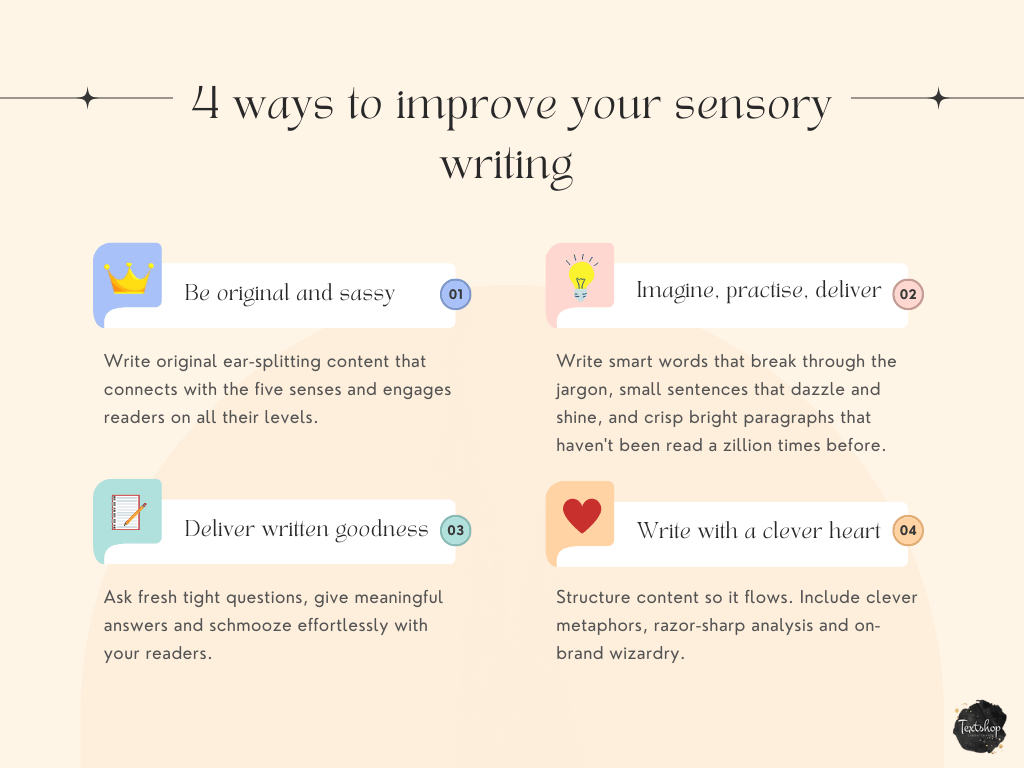Is there really a place for sensory language in business writing? The answer is a super-spicy, king-size yes and here are seven reasons you should be using it.
Sensory language provides vivid detailed imagery.
Research shows that the brain processes sensory language faster.
Readers can touch, feel, taste, hear and smell your words.
It injects personality and animation into your writing.
Your writing is stronger and more powerful.
Sensory language helps you captivate your audience.
It taps into readers’ emotions and engages them on multiple levels.
Sensory language uses the five senses – touch, sight, sound, smell and taste – to describe objects and experiences. The information collected by your five senses helps your nervous system interpret what’s happening around you.
Sensory words are usually descriptive (adjectives) and they’re related to emotions and feelings.
When you read sensory words, you feel as if you’re in the scenario being described by the writer. Walking through fresh green grass, for example, might evoke feelings of positivity and emotions such as joy and happiness. Whereas, sitting alone in an empty railway station evokes feelings of negativity and emotions like sadness.
On the other hand, when you read about ‘walking through the grass’ or ‘sitting in a railway station,’ the bland language doesn’t evoke any feelings or emotions. It’s lifeless.
Why does fresh language engage you more? How come you feel as if you’ve been transported into the photo on the right when you read about walking through fresh green grass? Let me explain.

When you read sensory words and phrases your brain processes them differently to non-sensory words. Your nervous system sends messages to your brain, which creates mental images that engage you on multiple emotional levels.
Let’s say you read a book that’s so engaging you can’t put it down, or a magazine article that makes you angry. Chances are these stories are sprinkled with sensory language that’s making you respond emotionally.
What we know for sure is that instead of processing the text for meaning, readers actually experience sensory language on one or more emotional levels.

Including sensory language in business writing is a skill that comes with practice. Usually, it’s a combination of conversational or semiformal writing plus sensory writing that engages your readers.
For example, on a web page where you’re writing about a new process, you might begin the discussion with a semiformal tone, then employ sensory language to describe a specific action. Perhaps you’ll even add in a sensory metaphor for variety and detail. Finally, when you summarise the topic you switch back to a semiformal business tone. Ultimately, you end up with a captivated audience because you brought the writing to life for your readers, instead of just ‘telling’ them about it.
Narration, which uses commentary to convey a story or a concept, can be enriched by sensory language.
You can transform a case study, a sequence of events, a descriptive narrative, as well as copywriting. Persuasive and informational writing are also more powerful when sensory words are included in the writing.

Following is a brief list of sensory words to use in your business writing. For a more extensive list check out my Complete guide to conversational writing or click on the button below the list here for a complete PDF copy.
Bright
Dazzling
Blushing
Bright
Crinkled
Freckled
Sprinkled
Glistening
Abrasive
Bumpy
Slippery
Prickly
Silky
Smooth
Tight
Warm
Bang
Crackling
Echoing
Rumble
Rustle
Splash
Thud
Whisper
Aromic
Bitter
Citrus
Earthy
Fresh
Mellow
Musty
Spicy
Bitter
Bland
Cool
Peppery
Sugary
Tangy
Tasteless
Creamy
Start schmoozing with your clients today.
‘Show not tell,’ is a rule in fiction writing that new authors often struggle with. When you ‘tell’ your readers what’s happening, it doesn’t engage them. But when you ‘show’ them, the story comes to life.
Anton Chekhov was inadvertently describing the show not tell rule when he wrote ‘Don’t tell me the moon is shining; show me the glint of light on broken glass.’
But let’s be realistic. While you can’t use the show not tell technique all the time in business writing, it’s great for adding depth and flair. And even better if you can achieve a sassy balance between showing and telling.
To sum up, sensory language is an essential component of ‘showing’ and it makes your writing realistic, immediate and engaging. But you’ll still need to do some ‘telling’ to communicate key messages, instructional copy and more formal types of business writing.
Tell: Sally was afraid to apply for the role when she saw the queue of applicants.
Show: Sally trembled and put her job application back in her sachet when she saw the long queue of well-dressed people.
Tell: With our new online platform, you can go straight to the page and type your comment.
Show: We’ve created a bright and colourful online platform and we’d love to see you log in and leave a comment about our updated system.
Are you wondering what a strong verb is? It’s when we use a stronger, more powerful, version of a basic verb. So instead of writing ‘run’, you’d write charge, race, dash or hurtle.
Instead of ‘write’ you would record, jot, note, scrawl or take notes. And you’d write scrutinise, examine, peruse or scan instead of ‘read’.
Once you get into the habit of using strong verbs, it’s easy – or, should I say, straightforward and breezy.
Use a synonym finder to find powerful replacements for basic verbs. My favourite is WordHippo. It never fails to present me with interesting alternatives.
Basic: He ran towards the door.
Strong: He dashed towards the door.
Basic: I’d wanted to visit the building since I read about it in a magazine.
Strong: I’d longed to visit the building since I read about it in a magazine.
Not all adverbs need to be squashed – only the pesky ones ending in ‘ly’. Okay, that’s most of them. The truth is adverbs such as beautifully, lightly, wearily and firmly weaken your writing.
For example, look at the sentence ‘He lightly wiped his desk.’ Take the adverb out and your sentence is stronger and clearer.
Nobel Prize-winning author Ernest Hemingway, detested adverbs. In fact, he used only 80 ly words per 10,000 words in his novels. Look at the masterful sentences below from The Old Man and the Sea.
‘Every day is a new day. It is better to be lucky. But I would rather be exact. Then when luck comes you are ready.’
The CEO angrily described the problem.
I’m certainly going to get one of those.
The applicant was waiting anxiously by the door.
Sensory language is perfect for writing metaphors and you may not notice how often you already do it.

Having a heated debate and the sweet smell of success are both sensory metaphors.
Avoid metaphors that are so overused they’ve turned into cliches. The words were music to his ears, is a good example of a copypasta keyword. Instead, put your brain to work and create original metaphors. Your readers will thank you.
She worked until every sentence felt like silk.
Let’s write fresh tight copy that’s effortless to read.
Talk about a super-spicy, sassy blog post!
Be careful where you write sensory language in serious, formal content. In these contexts, it can come across as out of tune and inappropriate.
Also make sure you use realistic sensory language. Using descriptive phrases that depict aliens or ancient history are probably a bad idea. Keep it familiar and inside your readers’ comfort zones, and analyse their likely reactions to what you’re writing, not your own feelings.
Use sensory language in business writing when you want your readers to imagine a scene, description, image or action. It’s a sure way to captivate them. Take care to use positive words when you want to create a bright, happy scenario. You might be surprised by the negative emotions triggered by hurried words.
For example, nervous can also mean excited. Break can mean both unexpected good luck and taking a rest. Clean, light and clear are ambiguous words that can undo good writing.
The takeaway? Keep an eye on the words you use and the emotional reactions they can generate.
In 2019, Leonie Rocek wrote her thesis around the question: Are customers influenced by sensory descriptions on food menus in restaurants?
It turned out that customers are influenced in a positive way by sensory descriptions of the food on offer. But it doesn’t stop there. Emotions also play a significant role.

Customers enjoyed the whole restaurant experience more, and they expressed a desire to return in the future. In addition, they perceived the food to be more valuable and of a higher quality.
What we can garner from this research is that readers trust information more when it engages their senses.
In another study, researchers found that sensory words are processed faster than non-sensory words. And a year later, more research published in the Brain and Language journal suggested that ‘conceptual processing is grounded in sensory systems.’ That a specific part of the brain lights up when processing sentences that include sensory metaphors.
*A metaphor likens one thing to another, and describes it in a way that isn’t literally true. For example, ‘drowning in a sea of grief,’ and Shakespeare’s ‘All the world’s a stage, and men and women merely players.’ We discuss the power of metaphors in sensory writing earlier in this post.
I hope you’ll include sensory language in your business writing. When it appears on the page at the right moment, it can impact your readers and clients in powerful ways.
The most important takeaway here is to publish original and authentic writing. Nobody wants to read fluffernutter sentences they’ve read a zillion times before. But they do want to grab a coffee, snuggle up and read inspiring original content. And you’ve got that. Right?
Publish exceptional content and it will win you new readers and clients all day long.
Did you know that 2.5x more people use search engines than any other platform?
Unlike social media, your website is real estate you own. So if you’re ranking high enough in Google, you have tremendous opportunities to get in front of masses of people.
I built the Textshop brand with high-ranking blog posts, and you can do it too.

Take this blog post, for example: Does my business need a blog? It’s ranking #6 – so not quite #1, but way up there on page one for the keyword I used.
How to write a smashing blog post is ranking #1. That’s right, the top of Google!
I even had a featured snippet on this post for several months (prime Google real estate).
Now for a blog post I loved writing: How to make your writing more powerful. It’s ranking #4 on Google – so I might update this post to give it a better chance of reaching #1. (Yes, you can update blog posts and not be penalised.)
Clearly, you don’t need to be a big company to rank highly in Google.
If I could get Textshop there, you can get your brand up there too!
Sharon is a content writer and award-winning editor. After acquiring two masters degrees (one in education and one in editing and comms) she worked in the publishing industry for more than 12 years. A number of major publishing accomplishments came her way, including the eighth edition of Cookery the Australian Way (more than a million copies sold across its eight editions), before she moved into corporate publishing.
Sharon worked in senior roles in medical colleges and educational organisations until 2017. Then she left her role as editorial services manager for the corporate arm of a university and founded Textshop Content – a content writing and copyediting agency that provides services to Australia’s leading universities and companies.
